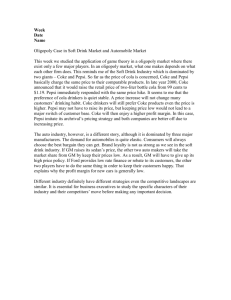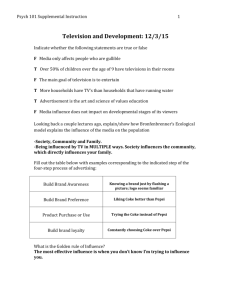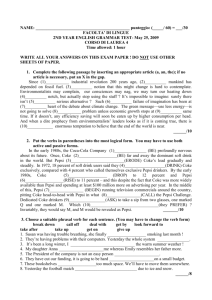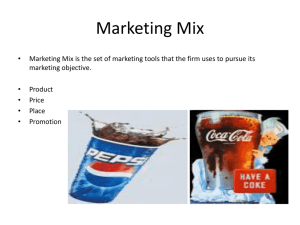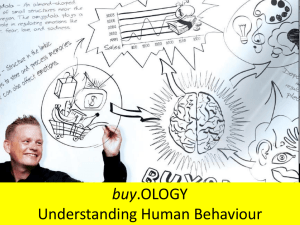G3_NeuroMKT_draft. 내려받기
advertisement
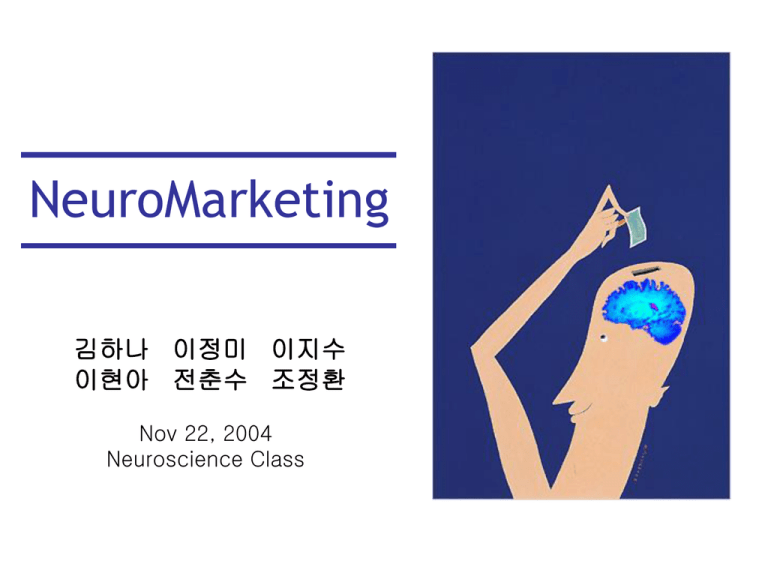
NeuroMarketing 김하나 이정미 이지수 이현아 전춘수 조정환 Nov 22, 2004 Neuroscience Class What is NeuroMarketing? ▪ NEUROSCIENCE + MARKETING ▪ The neurological study of a person's mental state and reactions while being exposed to marketing messages ▪ Using the tools of neuroscience, they are trying to learn more about the mental processes behind purchasing decisions ▪ 연구 주제+연구 방법+적용 범위를 종합하여 정의될 수 있음 Neuro + Marketing ▪ 공통점: 소비자 니즈에 대한 정확한 파악 및 기대 수준, 지각된 가치 등의 향상을 목표 ▪ 차이점 ① 방법론 기존 마케팅: 설문지, 포커스 그룹 인터뷰 등 사회조사분석법 사용(피험자 의 자기 보고에 의존) 뉴로 마케팅: 행동 및 의사결정 과정에서의 생물학적/신경과학적 설명이 가능한 도구들을 사용(Brain Imaging 등) -좀더 implicit한 수준의 설명 가능 ② 포괄 분야 기존 마케팅: 제품, 유통, 촉진, 판매에 있어서 전 과정을 다룸. 각 과정의 유기적 협력 강조 뉴로 마케팅: (현재까지는) 소비자 태도/행동 분석 및 이를 통한 마케팅 전 략 수립이 주 NeuroMarketing & NeuroEconomics ▪ 공통점 : 인간 의사결정 과정에 대한 신경과학적 연구 ▪ 차이점 - 신경 경제학: 게임 이론 등에 기초, 인간의 ‘합리적 의사결 정’에 관심. - 뉴로 마케팅: 소비자의 시장에서의 활동, 즉 구매 이전부터 이후의 활동 과정에 관심. NeuroMarketing ▪ 전통적인 조사 방법 설문조사 결과에 대한 통계학적 분석 (quantitative research) FGI에서 표현된 의견에 대한 분석 (qualitative research) ▪ 전통적 조사 방법의 한계 소비자들은 왜 한 속성군을 다른 속성군보다 선호하나? 소비자들은 어째서 특정 브랜드만을 고집하는가? 등을 밝히는데 취약. NeuroMarketing 전통적인 조사방법이 반영하지 못하는 점 ▪ 소비자들의 기억은 경험을 정확히 반영하지 못한다 ▪ 소비자들은 전략적으로 제시되는 마케팅 메시지를 수동적으 로 수용하는 것은 아니다 ▪ 소비자의 구매행동은 마음, 뇌, 주변 문화와 사회 등의 상호작 용으로 결정된다 NeuroMarketing 보완적이고 새로운 연구 방법 개발의 필요성 ▪ 소비자들 스스로 표현하는 것 이상을 파고들 수 있는 조사방법 필요하다 ▪ 수학적 분석의 발달로 보다 정교한 추론이 가능하지만 이런 추 론이 가능하려면 소비자들의 구매 행동 기저의 심리적, 생물학적 기제에 대한 연구가 뒷받침 되어야 한다. ▪ 경영자들은 자신들이 익숙한 절차, 방법론을 벗어나 다양한 사 회과학과 생물학 같은 낯선 학문분야의 성과도 검토해야 한다. ▪ 마케팅에 도움이 될 수 있는 중요한 분야 가운데 하나가 바로 뇌 과학이다 Which do you prefer, Coke or Pepsi? You guys found out that people prefer M to Q, not Pepsi to Coke. Which do you prefer, Coke or Pepsi? Montague et al.,Neuron,2004 1) What is the behavioral and neural response to these drinks when presented anonymously? 2) What is the behavioral and neural influence of knowledge about which drink is being consumed? 3) In questions 1 and 2, is there a correlation between the expressed behavioral preference and the neural response as measured using fMRI? Previous Studies ♦ Reward-related brain responses scale with the degree to which subjects find stimuli pleasing or rewarding (Knutson et al, 2001) Previous Studies ♦ Reward-related brain responses scale with the degree to which subjects find stimuli pleasing or rewarding (Aharon et al, 2001) Exp Procedures (Montague, 2004) ▪ 67 subjects Group 1 : Anonymous (3-trial) Group 2 : Anonymous (15-trial) Group 3 : Semianonymous Coke (3-trial) Group 4 : Semianonymous Pepsi (3-trial) Group 1 Group 2 Group 3 Group 4 Exp Procedures (Montague, 2004) ▪ Taste Tests Answers to the question Coke “Which drink you prefer to consume : Coke, Pepsi, or no preference?” -> STATED PREFERENCE Preferences exhibited during the taste tests -> BEHAVIORAL PREFERENCE Pepsi Exp Procedures (Montague, 2004) ▪ fMRI Task ♦ Setting & Protocol Siemens 3T scanner. Whole-brain EPI TR=2sec, TE=40ms, FA=90 ♦ Visual stimuli : Back-projected image on the mirror Group 1&2 (Anonymous) : Randomized red circle & yellow circle Group 3 (Semianonymous Coke) : Coke can & red or yellow circle Group 4 (Semianonymous Pepsi) : Pepsi can & red or yellow circle Results (Montague, 2004) Neural Correlates of Preference for Anonymous Coke and Pepsi Delivery ▪ Behavioral preferences expressed in the 3 & 15 trial taste test varied linearly with brain responses in the VMPFC(VentroMedial PreFrontal Cortex) Results (Montague, 2004) Subjects demonstrated a strong bias in favor of the Labeled Coke ▪ Results (Montague, 2004) ▪ Average scores of 3 behavioral task - Prefer the labeled Coke drink over anonymous Coke - The Coke label had a bigger effect in biasing subjects’ preferences than the Pepsi label Later No different from the results in Anonymous test !! Results (Montague, 2004) Hippocampus/DLPFC(DorsalLateral PreFrontal Cortex)/midbrain No voxels survive threshold Discusssion (Montague,2004) ▪ When judgments are based solely on sensory information, relative activity in the VMPFC predicts people’s preference ▪ Brand knowledge biases preference decisions and recruits the hippocampus, DLPFC and midbrain VMPFC and hippocampus/DLPFC/midbrain might function independently to bias preferences based on sensory and cultural information, respectively Related Studies ▪ Erk, s. et al., Neuroreport,2002 Sponsored by DaimlerChrysler Measured fMRI signals while subjects looked at pictures of cars and rated their attractiveness The subjects were more attracted to sports cars than to limousines or small cars, and the sports cars elicited greater activity in brain reward areas Related Studies ▪ Clint Kilts (Emory Univ,2003) “That's just so me!" ⇒ increased activity in medial prefrontal cortex Measured fMRI signals while subjects looked at pictures of products and rated their preferences Brain activity was greater in medial prefrontal cortex when subjects saw the products they preferred medial prefrontal cortex : sense of self (ex. Phineas Gage) Related Studies ▪ FKF research (2004) Joshua Freedman , Marco Lacoboni (California Univ) Subjects : 10 Democrats & 10 Republicans Measured fMRI signals while subjects looked at pictures of Bush & Kerry, Political campaigns and related video images Related Studies ① Democrats were more sensitive to danger Democrats showed greater activity in amygdala when they saw the images of 9/11 or Daisy commercial Amygdala : related to fear & anxiety ② Rational response to the candidate who belongs to the opposite party 1) Bush & Kerry - VMPFC(emotional response) 2) After campaign - Activity in DLPFC to the opposite party’s candidate 3) DLPFC : related to rational response Criticisms ▪ NGO ▪ Increased incidence of marketing-related diseases obesity, type 2 diabetes, alcoholism, eating disorders, smoking-related illnesses. ▪ More effective political propaganda the use of propaganda in service of totalitarianism, hatred and genocide, in Nazi Germany, Soviet Russia, Cambodia, Rwanda, Burundi, East Timor and Kosovo ▪ More effective promotion of degraded values materialism, addiction, violence, gambling, pornography, antisocial behavior Criticisms ▪ Consumers ▪ What if I have a Buy Button in my Brain? ▪ What if I can’t control myself? A letter to the Senate Committee on Commerce, Science and Transportation, asked for an investigation of neuromarketing ''What if they then could trigger this neural activity by various means, so as to modify our behavior to serve their own ends?'' “Gross misunderstandings and distortions of both the power of brain imaging technology and its use in marketing” NeuroMKT-Related Companies Neurosense Limited. Oxford, UK. BrightHouse Neurostrategies Group. Atlanta, GA, USA. Market Psychology Consulting. (Finance) San Francisco, CA, USA SalesBrain, LLC. San Francisco, CA, USA and Paris, France. Shop Consult. Amstetten, Austria. Prospects ▪ New paradigm of MKT Behavioral Studies + Neuroscientific approach ▪ Beyond MKT, it’s about Decision-making process “It is easy to be seduced by colorful pictures of brain activity and to believe that these images are rich in scientific content. But the images are highly processed and cannot be interpreted without a detailed understanding of the analytical methods by which they were generated” (Editorial, Nature Neuroscience, July 2004)
